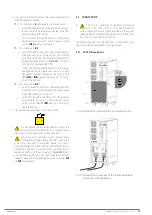
21
ristors) to the booster input, and this converter will be discon-
nected from the AC input (except for hybrid operating modes).
In terms of charging the batteries, this will occur when the UPS
is working in normal mode (AC voltage network present, AC/DC
rectifier operating). The UPS has a reducer converter ("buck"),
which is supplied by the DC bus voltage, adjusting it to the re-
quired levels for charging the batteries. This battery charging
includes 2 basic stages, or even 3 (depending on the type of
battery):
•
Constant current
: if the set charge current is not exceeded,
the output voltage of the charger will be dynamically ad-
justed to achieve this allocation.
•
Constant voltage
: once the battery floating voltage is
reached, the charge current will decrease. This floating
voltage must be maintained in normal mode, a voltage that
will be readjusted depending on the temperature.
•
Quick charge or "boost" voltage
: depending on the type of
battery (chemistry), an intermediate stage can be config-
ured, after charging at constant current and before allo-
cating continuous float voltage, which consists of supplying
the batteries with a voltage that is higher than the floating
voltage for a limited time, in order to obtain a quicker and
more efficient recharge.
The architecture of the charger is based on a double reducer
converter: from positive and negative semi-buses, positive and
negative battery charge voltages and currents are obtained.
The switching of the charger's IGBTs also consists of a PWM
controlled digitally by DSP.
The charger incorporated as standard in the units allows the
batteries to be recharged for both standard autonomy and for
extended autonomy (greater capacity in Ah installed).
4.4.5. Static bypass
The static bypass switch allows the load or loads to be switched
between the inverter and the emergency (or bypass) line, and
vice versa, without interruption. This bypass line may or may
not be common to the rectifier AC input.
The switching of the output load to the bypass line can be or-
dered manually, or it can be activated by the UPS automatic con-
trol in certain emergency situations.
As power switching elements, it uses thyristors (SCR) and re-
lays. Thyristors for connecting/disconnecting the voltage of the
bypass line to the loads, relays for connecting/disconnecting
the inverter voltage.
4.4.6. Manual or maintenance bypass
The manual bypass is used to isolate the UPS from the input
voltage and loads, supplying the load directly from the input
network in the event of maintenance or serious faults.
It consists of a switch, supplied as standard and integrated in
the unit, which allows the bypass or emergency line voltage
(common to the rectifier AC input, or not) to be connected
directly to the output, by simply activating this switch and
without the intervention of a converter or controlled electronic
device. Just an auxiliary signal will notify the UPS control that
this switch is activated.
The manual bypass switch supplied in the unit has a mechan-
ical lock that makes it impossible for it to be activated acciden-
tally by unqualified staff.
External manual bypass
In addition to the standard internal manual bypass, it is also
possible to optionally install an external manual bypass.
4.5. OPERATING MODES
The UPS "standby" or stopped status, is the one in which the
UPS is powered but with the converters completely stopped,
for various reasons:
•
Before initial start-up.
•
By command or manual request.
•
Due to a block alarm that forces this situation.
In this "standby" status, depending on the previous situation
from which we come, we may find that the UPS does not supply
any voltage to the Output, or that the static Bypass is connected
and supplying voltage to the Output:
1.
In a first start-up, normally the UPS will not supply any
voltage (see
). This situation can also be reached after
an emergency stop (EPO), total shutdown of the UPS, and
then re-power the UPS with the emergency stop disabled.
2.
In UPS shutdown maneuvers, after it has been oper-
ating in normal mode, or after the initial start-up
and forcing the transfer to static bypass on the display,
the
UPS will supply the Bypass voltage to the Output (to
the loads) even when completely stopped, if the input
switch (or separate bypass switch if applicable) and
the output switch are closed (to ON)
. In this situation,
the Rectifier, Charger and Inverter will not be working. See
From this "standby" status (either supplying voltage through
the Bypass or not), the UPS can start working in different oper-
ating modes, which can be reached automatically, or forced by
manual operator action. These operating modes, described in
detail in successive sections, are:
•
Normal mode.
•
Battery mode (autonomy mode).
•
Bypass mode.
•
Maintenance bypass mode.
•
ECO mode.
•
Frequency converter mode.
SLC CUBE4
- UNINTERRUPTIBLE POWER SUPPLY SYSTEM
-
USER MANUAL
Содержание SLC CUBE 4
Страница 1: ...30 80 kVA USER MANUAL UNINTERRUPTIBLE POWER SUPPLY...
Страница 74: ...74 SALICRU...
Страница 75: ...75 SLC CUBE4 UNINTERRUPTIBLE POWER SUPPLY SYSTEM USER MANUAL...
Страница 76: ...76 SALICRU...
Страница 77: ...77 SLC CUBE4 UNINTERRUPTIBLE POWER SUPPLY SYSTEM USER MANUAL...
















































